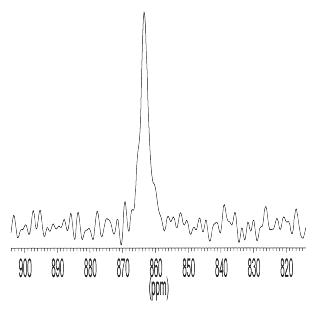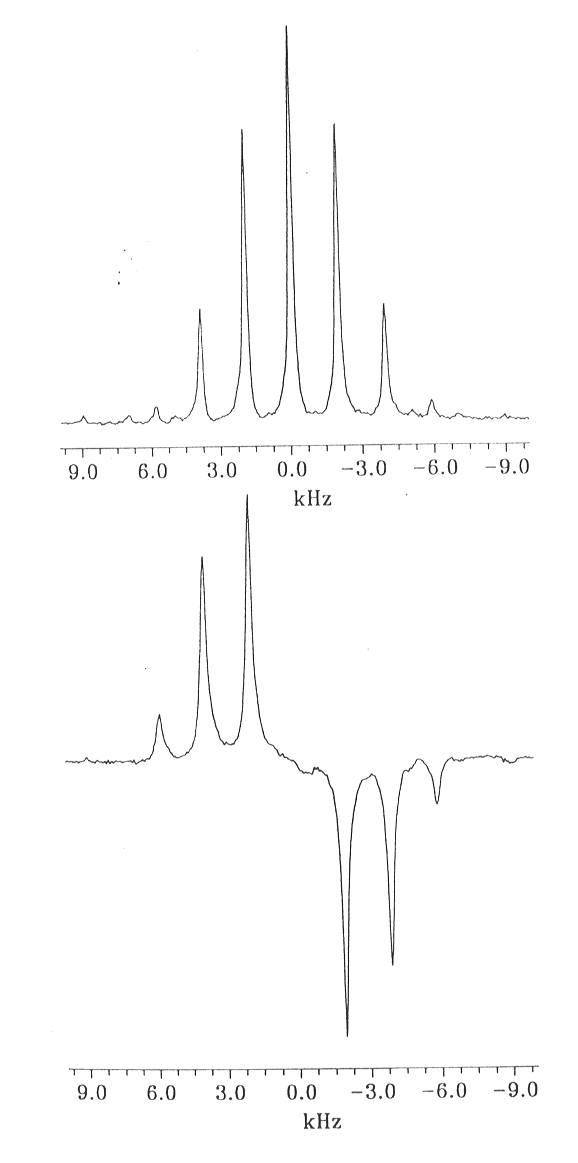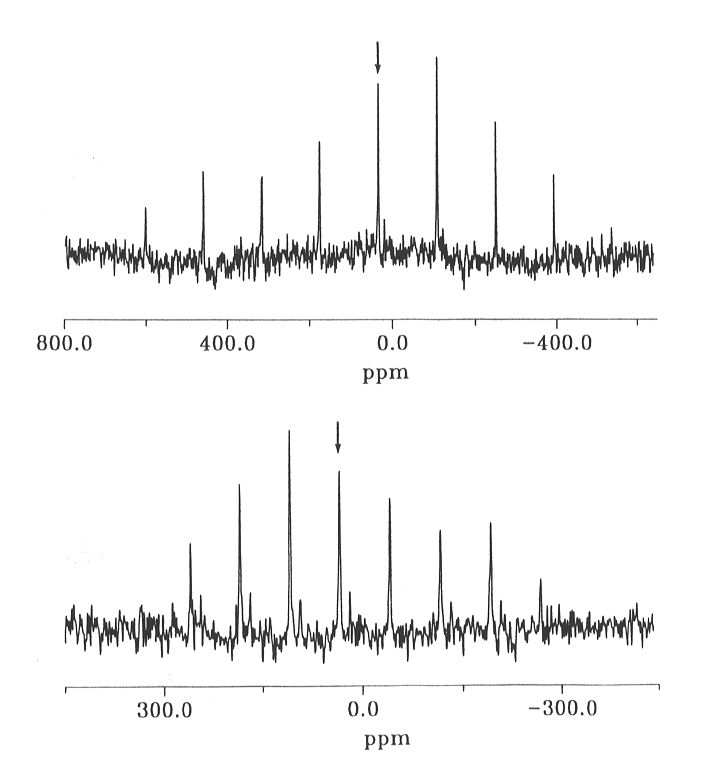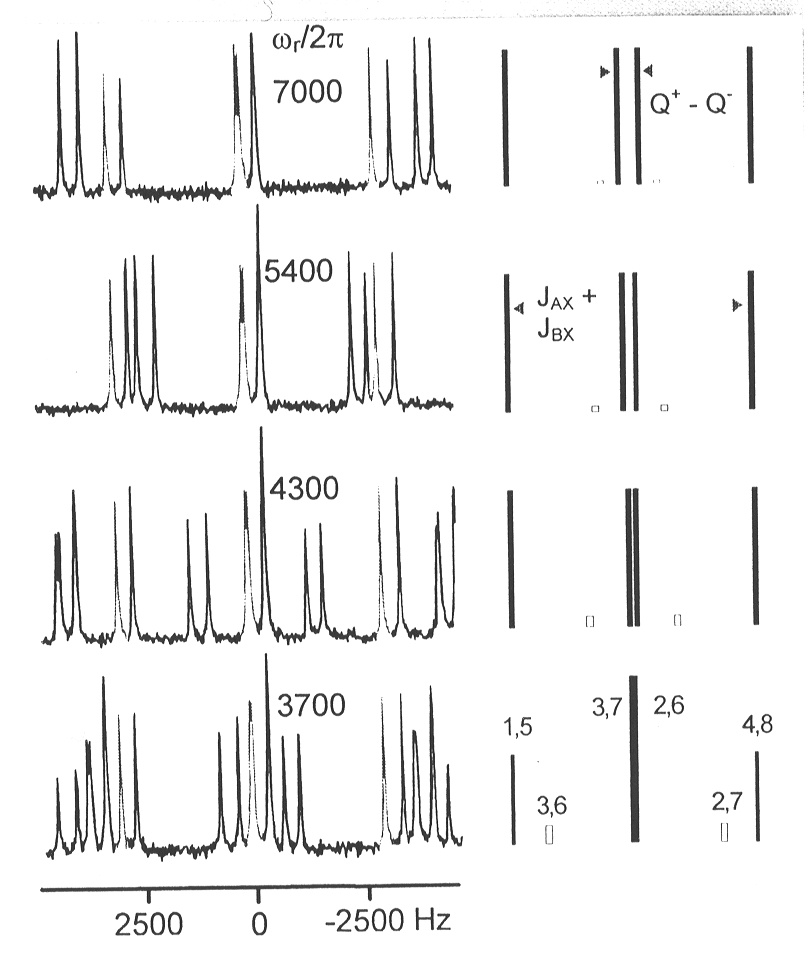

Installation of the 3-channel 100 MHz NMR spectrometer has been completed and the newly-acquired 200 MHz NMR spectrometer is also fully installed and in operation. Some methodological mile-stones will be sketched briefly:
i) cross polarisation 31P ->
113Cd
The feasibility of this experiment on the 100 MHz instrument had to
be tested, including optimisation of the hardware. The most suitable compound
for these test experiments is CdSiP2; the 31P ->
113Cd CP/MAS spectrum of CdSiP2 is shown in Fig.
3.10-12 (samples of CdSiP2 were kindly donated by H. Eckert,
Münster and M. Hönle, Stuttgart).
 |
Fig. 3.10-12: 31P -> 113Cd CP/MAS spectrum of CdSiP2 |
ii) 29Si MAS, CP/MAS with simultaneous 1H and
31P decoupling
The presence of more than one 31P nucleus directly bonded
to Si, renders the corresponding 29Si MAS, CP/MAS spectra hopelessly
complicated (in most cases) to the point where it is not even possible
to determine the number of 29Si resonances present in the spectra.
For such cases it is necessary to be able to fully decouple 31P
(and 1H) from 29Si. This triple-resonance experiment
has been successfully implemented and an example is shown in Fig. 3.10-13:
the organometallic compound tBuSi-(Pchex)3-SitBu
has a molecular backbone of two crystallographically distinct Si-atoms,
connected by three P atoms as bridging elements. Only the 29Si
CP/MAS spectrum obtained under simultaneous 31P and 1H
decoupling correctly reveals the two crystallographic Si sites (this compound
was kindly donated by M. Drieß, Heidelberg).
 |
Fig. 3.10-13: 29Si CP/MAS spectra of tBuSi-(Pchex)3-SitBu: |
iii) The very first INEPT experiment on crystalline solids
Polarisation transfer via J-coupling is of fundamental importance in solution-state NMR, while for solids the usual mechanism of polarisation transfer occurs via dipolar interactions. J-coupling is closely related to chemical bonding and is, thus, complementary to dipolar interactions depending on geometric distances. Therefore, it is highly desirable to be able to exploit polarisation transfer paths via J-coupling also for solids. We have applied this J-coupling transfer experiment (INEPT, originally designed for isotropic liquids) to obtain the 195Pt MAS spectrum of solid (NMe4)2[PtF6] via 19F-195Pt heteronuclear J-transfer (see Fig. 3.10-14). The possibility to exploit J-coupling polarisation transfer paths for solids under MAS conditions will be of general importance for non-13C-1H applications of high-resolution solid-state NMR techniques (PtF62- salts were kindly donated by P. Preetz, Kiel).
 |
Fig. 3.10-14: 19F -> 195Pt INEPT/MAS spectrum of (NMe4)2[PtF6] (bottom) |
iv) 171Yb CP/MAS
Yb in its more common formal oxidation state Yb(III) is paramagnetic.
More recently, Yb(II) chemistry has attracted attention owing to the high
reactivity of Yb(II) compounds. Yb(II) compounds are diamagnetic, though
highly air-sensitive. The isotope 171Yb has NMR properties quite
similar to the isotope 199Hg, and we could show for the first
time that 171Yb CP/MAS spectra of crystalline solids can be
obtained by approaching an experimental 171Yb CP/MAS set-up
from a pre-set 199Hg CP/MAS set-up. The first 171Yb
CP/MAS spectra of two Yb(II) complexes are shown in Fig. 3.10-15 (samples
were kindly donated by G. Rabe, München).
 |
Fig. 3.10-15: 171Yb CP/MAS spectra of (bottom) cp*2Yb(thf) · 0.5 toluene and of (top) cp*2Yb(thf)2 (cp* = C5Me5, thf = tetrahydrofuran) |
v) The X-part in solid-state ABX spin systems under MAS
A solid-state spin system consisting of a homonuclear spin pair plus
a heteronucleus represents an often encountered fragment in inorganic and
organometallic chemistry. The fragment (31P)2M in
transition metal phosphine complexes constitutes such an ABX spin system
where the X-part displays the complex (Bo- and νrot-dependent)
properties of the strongly coupled AB-part. The spectral properties of
the X-part of solid-state ABX spin systems under MAS have been theoretically
predicted, now we have observed these properties experimentally for the
first time in the 195Pt CP/MAS spectra of a Pt(II) phosphine
complex, depePt(S-C≡ C-tBu)2.
The centre band region of the respective 195Pt CP/MAS spectra
is shown in Fig. 3.10-16 (samples were kindly donated by W. Weigand, München).
 |
Fig. 3.10-16: 21.4 MHz 195Pt CP/MAS spectra (only centre band region is shown) of depePt(S-C≡ C-tBu)2 (depe = Et2P-CH2-CH2-PEt2) at different MAS frequencies; also shown calculated resonance positions and intensities |

Tel: +49-(0) 921 55 3700 / 3766, Fax: +49-(0) 921 55 3769, E-mail: bayerisches.geoinstitut(at)uni-bayreuth.de
 Previous page
Previous page